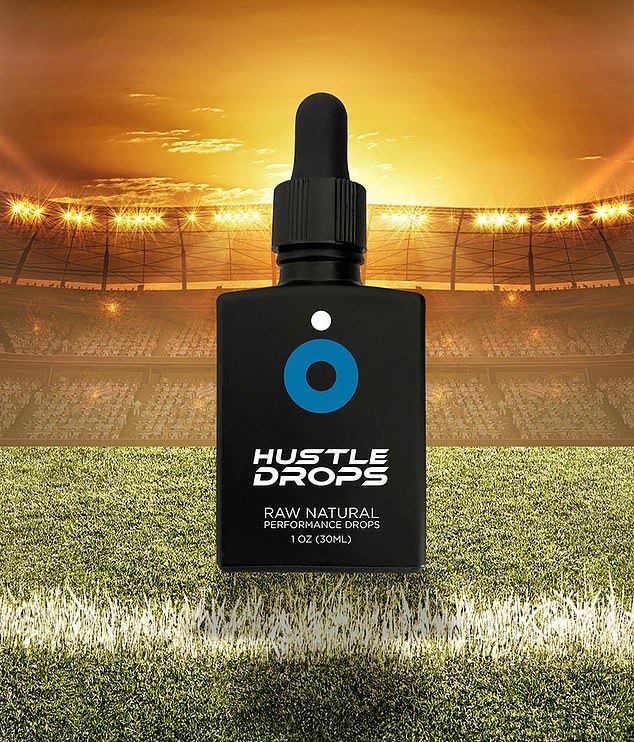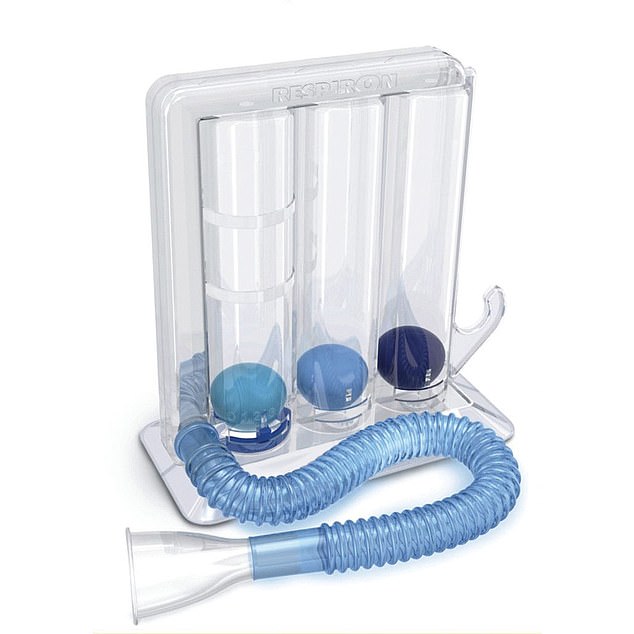From asthma to stress and fatigue… Could these gadgets help you breathe easy?
We breathe an estimated 25,000 times a day and usually don’t realize we are doing so. For some this may not be so easy, for example due to asthma or after surgery. But can products that improve lung function make a difference? ADRIAN MONTI asked experts to rate a selection, which we then rated.
Busy drops
30ml, £25, dropfx.com
CLAIM: This liquid supplement contains peppermint, coconut, monk fruit, and wintergreen. Use the supplied pipette to place a drop on the back of the tongue. This, the maker says, will immediately “expand your airways” and “boost oxygen flow and performance” to improve “energy levels, clarity of mind, and breathing efficiency.” Advantages ‘sustainable for one to three hours’.
EXPERT VERDICT: Sucking a peppermint candy can sometimes make breathing easier if you have a cold or stuffy nose, because the menthol it contains can act on receptors in the nose and sinuses to reduce mucus production, says Professor Pallav Shah, a consultant physician in in respiratory medicine at the Royal Brompton Hospital in London.
‘But I have seen no evidence that these types of drops have any long-term impact. I think the maker is overselling the product by saying it will expand the airways and stimulate oxygen flow in this way.” 2/10
Humans breathe an estimated 25,000 times a day using our lungs

This liquid supplement contains peppermint, coconut, monk fruit, and wintergreen
Buteyko belt
£22.75, Amazon.co.uk
CLAIM: This adjustable belt, worn between the chest and belly button, will “reduce snoring, sleep apnea, asthma, stress anxiety, and other breathing problems,” says its maker. It applies ‘gentle resistance’ so that you breathe lighter than normal, and ‘experience calmness all day long’. It can be worn while you work, exercise and sleep.
EXPERT VERDICT: Dr. Simon Taggart, a chest consultant and GP at Spire Manchester Hospital, says: ‘I can see this belt has potential as a way to perform respiratory muscle training.
‘Presumably it has some elasticity, so it works in the same way as a resistance band you might use in a gym; By restricting your breathing slightly, you train your lungs and breathing muscles.
“But for asthma, I would try a patient on inhalers rather than recommending a belt like this.” Relying solely on this belt can make things worse.
‘I don’t see how it would help with sleep apnea or snoring, because other mechanisms could be involved, for example blocked or narrowed airways.’ 4/10
Tilcare Respiratory muscle trainer
£22.99, Amazon.co.uk
CLAIM: Breathing in and out into this pipe-shaped plastic device will, the maker says, strengthen your diaphragm muscles and “increase the volume capacity of your lungs, allowing you to breathe deeply and get more oxygen into your blood.”
The maker suggests using it for five minutes once a day and says it provides breathing support for asthma and chronic obstructive pulmonary disease (COPD), for people who have had a stroke or have Parkinson’s disease.
EXPERT VERDICT: ‘This creates a certain resistance as you breathe through it,’ says Professor Shah. ‘It could help people with chronic bronchitis or COPD, which narrows the airways and causes shortness of breath.
‘It could help them bring mucus secretions up into the lungs more easily by strengthening their intercostal (rib) muscles.
‘But I’m hesitant about whether it helps with asthma. This device would not improve your lung capacity – which you cannot physically increase. But with regular use, it can make your lungs more efficient by strengthening the diaphragm. I don’t think it’s worth buying as it will only make a small difference, unlike quitting smoking for example.’ 5/10
Powerbreathe Respiron
£11.99, powerbreathe.com
CLAIM: The maker says this device (which consists of a tube attached to a small, clear plastic box with three chambers) “helps maintain lung capacity and function after periods of inactivity” by promoting deep breathing. By breathing forcefully into the mouthpiece, a small plastic ball ‘floats’ in each chamber. Use it after heart or lung surgery and ‘the quality of your breathing improves’.
EXPERT VERDICT: “Studies have shown that these types of devices – where you breathe in or out against resistance – are very effective,” says Dr. Taggart. ‘It has been shown that COPD patients become less breathless for about ten minutes a day for twelve weeks. It can also help patients with heart failure, because stronger muscles make it easier to clear the sticky mucus from their lungs.
‘This cheap and cheerful device is very good. I would recommend it to anyone with a weak diaphragm.’ 9/10

The maker says this device ‘helps maintain lung capacity and function after periods of inactivity’ by encouraging deep breathing
BreathSync Necklace for Stress and Anxiety Relief
£17, theblowered.com
CLAIM: Using this you can “quickly and easily achieve calm and focus by slowing your breathing” as a “relief from anxiety and stress,” says its creator. Bring it to your lips like a whistle, inhale deeply through your nose and then exhale gently through the pendant, focusing on ‘lengthening your exhale’. The maker claims it will lower heart rate and aid in deeper sleep.
EXPERT VERDICT: ‘This device will appeal to people with issues around stress and anxiety reacting to tangible things; Having this around their neck can help remind them to think about their breathing,” says Dr Ari Manuel, a respiratory and sleep specialist at Liverpool University Hospitals NHS Foundation Trust. It could also help people who hyperventilate to regulate their breathing, “because it encourages you to focus on doing it more slowly and in a controlled way,” he says. “But it won’t work for everyone.” 4/10
MIR SmartOne
£128.40, pmsinstruments.co.uk
CLAIM: This pocket-sized device is suitable for people with ‘asthma, cystic fibrosis or COPD’ who need to self-monitor their breathing, the website claims. It is a spirometer: a device that measures how much air you can breathe in and out.
You blow into a mouthpiece that is connected to a smartphone app via Bluetooth. It measures lung function by recording how fast and hard the air is blown out. The results can be sent to a healthcare provider.
EXPERT VERDICT: Professor Shah says: ‘We give patients with cystic fibrosis or who have had a lung transplant a spirometer to monitor lung function. If you are asthmatic I am not sure if this device plays a role as if you are out of breath that is enough to indicate that your condition is not adequately controlled.
‘For someone with COPD, this can be an early sign that their lungs are deteriorating.
‘But spirometry at home is never as good as when it is done by a healthcare provider.’ 6/10
Oxygen Pro canister
15L, £19.99, amazon.co.uk
CLAIM: Press the trigger on the inhaler cup to release a blast of 99.5 percent pure oxygen directly into your mouth.
The maker says it ‘provides respiratory support during illness and can relieve fatigue and stress’.
It also claims to improve concentration.

Press the trigger on the inhaler head to release a blast of 99.5 percent pure oxygen directly into your mouth
EXPERT VERDICT: Dr. Taggart emphasizes that anyone who needs oxygen for a medical condition should get it from the NHS, where it is provided under strict supervision – ‘pure oxygen can be very dangerous and cause a large explosion if it comes into contact with an open flame’ , he says. .
While severe shortness of breath due to COPD means not enough oxygen is being inhaled, it can also mean a patient is retaining too much carbon dioxide instead of exhaling it, he says. ‘If you had this problem, breathing pure oxygen from a can of carbon dioxide could cause narcosis (where excess carbon dioxide causes a reduced level of consciousness). In the longer term, this can lead to respiratory arrest.
‘This is why COPD patients in the hospital are given a low dose of medical oxygen – about 24-35 percent pure oxygen – and the cylinder has a regulator to regulate the flow.
‘But with this product you give yourself a random blast, entirely at your own discretion.’ 0/10
